Are you a Quiet Speculation member?
If not, now is a perfect time to join up! Our powerful tools, breaking-news analysis, and exclusive Discord channel will make sure you stay up to date and ahead of the curve.
My expectations weren't high when I went to open the full Battle for Zendikar image gallery. Like Jordan, I wasn't thrilled to see the first half of BFZ over the past few weeks, and was worried about what the rest of the set would hold. After seeing all 274 cards, I'm officially joining Jordan in the doldrums. As a Modern player, I have a hard time getting excited about three-mana Rampant Growths or conditional Essence Scatters. Reverse power creep has never felt more real. Community reactions to BFZ have shared Jordan's and my enthusiasm, particularly among Modern crowds. Everyone I've talked to or heard from has lamented the lack of playables, the absence of key reprints, and the missed opportunities in card design.
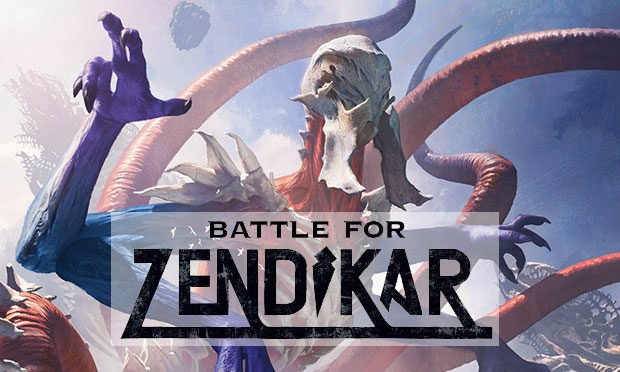
Now that I've calmed down from my first exposure to a three-mana Birds of Paradise, the set is admittedly looking a little better. Emphasis on "a little": this is still one of the weaker Modern releases in recent memory, although Battle for Zendikar still has more potential than many are giving it credit. With Tarkir block fresh in everyone's minds, most of us went into BFZ spoiler season with high hopes for more format-defining cards like Tasigur, Kolaghan's Command, and Monastery Swiftspear. Unreasonably high hopes, in most cases. In this article, I'll try to boost Modern morale around Magic's newest set, highlighting some of the better cards that could still impact the format.
[wp_ad_camp_1]
Battle for Zendikar's Top 5
It's true that BFZ suffers from both design-level and power-level problems (Paulo Vitor Damo da Rosa wrote a spot-on critique of the set yesterday). Thankfully, even the weakest sets still have something to offer Modern, and Battle for Zendikar is no exception. Here are five cards which are likely to see Modern play. Disclaimer before we get started: none of these cards should come as big surprises. Sometimes we'll get a weaker set for non-rotating format play. When that happens, what you see is exactly what you'll get, so don't expect too many sleepers or under-the-radar gems here.
5. Retreat to Coralhelm
I don't remember the last time the Modern community went so crazy about a new card and a new combo. As everyone can't stop discussing on MTG Salvation, Reddit, and even the Legacy-oriented The Source, [tippy title="Retreat to Coralhelm" width="330" height="330"]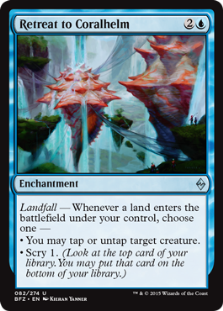 [/tippy]
[/tippy]  combines with Knight of the Reliquary to win the game on the spot. With a Knight and Retreat on the battlefield, simply activate the Knight and fetch a Forest, Plains, or fetchland. This triggers Retreat which untaps the Knight, allowing you to get another land or crack a fetch to stack triggers and "double up" on land searches. When the dust settles, you'll have a graveyard full of lands and a Knight in the 20/20 range. Add in Kessig Wolf Run as a mana-sink and countermeasure against chumpblockers, and Sejiri Steppe to stop removal or single-color blockers. Excess Retreat triggers even tap down blockers! You can get the combo online as early as turn three with help from Noble Hierarch or Birds of Paradise, and the Knight can be Bolt-proof if you lead with two fetchlands.
combines with Knight of the Reliquary to win the game on the spot. With a Knight and Retreat on the battlefield, simply activate the Knight and fetch a Forest, Plains, or fetchland. This triggers Retreat which untaps the Knight, allowing you to get another land or crack a fetch to stack triggers and "double up" on land searches. When the dust settles, you'll have a graveyard full of lands and a Knight in the 20/20 range. Add in Kessig Wolf Run as a mana-sink and countermeasure against chumpblockers, and Sejiri Steppe to stop removal or single-color blockers. Excess Retreat triggers even tap down blockers! You can get the combo online as early as turn three with help from Noble Hierarch or Birds of Paradise, and the Knight can be Bolt-proof if you lead with two fetchlands.
Is Coralhelm Knight (or whatever the community names the deck) good in Modern? That's a great question. I've tested a few lists and found them to be better than existing Bant builds, but still worse than most top-tier decks.  Early versions also fail the "Why not Twin?" question Modern players must so often ask. That said, Bant has always been a fringe-playable color pairing even before BFZ. Indeed, Bant Company emerged as one of the best MTGO decks during the summer. Retreat is poised to make the deck more viable. What Bant lacks in early game interaction (Path to Exile instead of Lightning Bolt) it makes up for in strong creatures, high-end removal, ramp, and now a combo finish. Never underestimate the power of proactive strategies in Modern and Bant can now join this club. I don't see Retreat breaking out as a tier 1 or even tier 2 deck in the near future, so if you spent $15+ on your newly acquired Knights I'd offload those sooner rather than later. That said, I do see more players both exploring Bant strategies and having more tools to build with. Proactive win conditions like Retreat/Knight define the format, and I will be surprised if something strong doesn't emerge from this by the end of the year.
Early versions also fail the "Why not Twin?" question Modern players must so often ask. That said, Bant has always been a fringe-playable color pairing even before BFZ. Indeed, Bant Company emerged as one of the best MTGO decks during the summer. Retreat is poised to make the deck more viable. What Bant lacks in early game interaction (Path to Exile instead of Lightning Bolt) it makes up for in strong creatures, high-end removal, ramp, and now a combo finish. Never underestimate the power of proactive strategies in Modern and Bant can now join this club. I don't see Retreat breaking out as a tier 1 or even tier 2 deck in the near future, so if you spent $15+ on your newly acquired Knights I'd offload those sooner rather than later. That said, I do see more players both exploring Bant strategies and having more tools to build with. Proactive win conditions like Retreat/Knight define the format, and I will be surprised if something strong doesn't emerge from this by the end of the year.
4. Ulamog, the Ceaseless Hunger
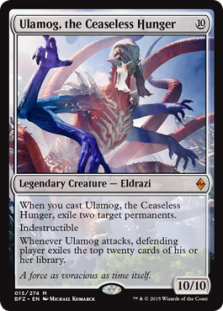 For an Eldrazi-themed set, Battle for Zendikar sure skimped on the big bad Cthulhus. Emrakul, the Aeons Torn is a real Eldrazi. [tippy title="Herald of Kozilek" width="330" height="330"]
For an Eldrazi-themed set, Battle for Zendikar sure skimped on the big bad Cthulhus. Emrakul, the Aeons Torn is a real Eldrazi. [tippy title="Herald of Kozilek" width="330" height="330"]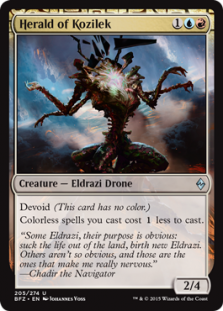 [/tippy]? Not so much. The only exception to this is the mighty [tippy title="Ulamog, the Ceaseless Hunger" width="330" height="330"]
[/tippy]? Not so much. The only exception to this is the mighty [tippy title="Ulamog, the Ceaseless Hunger" width="330" height="330"] [/tippy], a true Elder God monster worthy of its creature type. Recent RG Tron lists have shied away from including Ulamog's previous incarnation, Ulamog, the Infinite Gyre, instead opting for 1-2 Ugin, the Spirit Dragons and/or Sundering Titans. We saw this in both the Top 8 and Top 16 Tron lists out of August's SCG Open in Charlotte. Call me optimistic, but I see new Ulamog ("Newlamog" as some have affectionately dubbed the card) reversing that trend. Ulamog is surprisingly nasty in a number of matchups, setting combo decks like Twin back in mana development, defeating Abzan Company players after they've gained billions of life, smashing mirror-match Karns and lands, etc.
[/tippy], a true Elder God monster worthy of its creature type. Recent RG Tron lists have shied away from including Ulamog's previous incarnation, Ulamog, the Infinite Gyre, instead opting for 1-2 Ugin, the Spirit Dragons and/or Sundering Titans. We saw this in both the Top 8 and Top 16 Tron lists out of August's SCG Open in Charlotte. Call me optimistic, but I see new Ulamog ("Newlamog" as some have affectionately dubbed the card) reversing that trend. Ulamog is surprisingly nasty in a number of matchups, setting combo decks like Twin back in mana development, defeating Abzan Company players after they've gained billions of life, smashing mirror-match Karns and lands, etc.
Lantern Control's recent success also bodes well for Ulamog: it's one of Tron's best outs to the Ensnaring Bridge/Spellskite/Welding Jar locks that neither Karn Liberated nor Oblivion Stone can handle. I expect all the Tron decks that were running Titans to switch those out for our new Eldrazi overlord. Bonus points for chaining the turn three [tippy title="Conduit of Ruin" width="330" height="330"]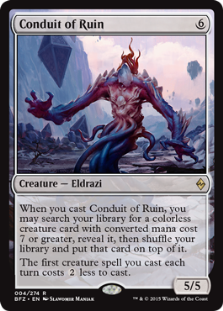 [/tippy] into a turn four Ulamog.
[/tippy] into a turn four Ulamog.
3. Tangolands
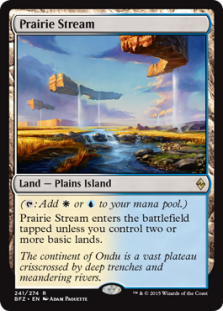 We're seeing a UW Control renaissance in Modern, and [tippy title="Prairie Stream" width="330" height="330"]
We're seeing a UW Control renaissance in Modern, and [tippy title="Prairie Stream" width="330" height="330"] [/tippy] will be joining the force once BFZ hits tournaments in October. Between Yuuya Watanabe's Worlds 2015 performance and a series of recent SCG Open and Premier IQ wins (as recently as last weekend), UW Control looks like the real deal: I'm still standing by my August metagame prediction that the deck will be tier 2 in our next update. Stream is an unassuming but significant addition to these decks, particularly in lists like Phil Silberman's that rely on Emeria, the Sky Ruin to drown opponents in mid and late-game resources.
[/tippy] will be joining the force once BFZ hits tournaments in October. Between Yuuya Watanabe's Worlds 2015 performance and a series of recent SCG Open and Premier IQ wins (as recently as last weekend), UW Control looks like the real deal: I'm still standing by my August metagame prediction that the deck will be tier 2 in our next update. Stream is an unassuming but significant addition to these decks, particularly in lists like Phil Silberman's that rely on Emeria, the Sky Ruin to drown opponents in mid and late-game resources.
I include all the Tangolands in this category because I see them incentivizing players to try out two-colored decks in Modern. Historically, Modern control and midrange strategies have been dominated by three-colored approaches: Jund, Abzan, Jeskai Control, Grixis Control, etc. Even Twin, the traditional two-colored holdout, has seen plenty of three-color iterations including the summer's breakout performance of Grixis Twin. Tangolands don't place nicely in these 3+ color lists, although I still suspect we'll see 1-2 tossed in after all the color pairings are released. In the UW and BG lists, however, the Tangolands are really going to shine, providing fetchable and painless manafixing as the game progresses. Also, in case you were as confused as I was about the lands' name, it comes from the phrase "it takes two to tango". I don't know if the name will stick, but the lands sure will as more players shift towards UW Control and similar two-color strategies. Just be careful to watch your mana requirements before investing too heavily in these lands. Twin, for instance, will need both Cryptic Command and Splinter Twin mana by turn four, and Tangolands can interfere with that.
2. Lumbering Falls
Although not as unassuming as [tippy title="Prairie Stream" width="330" height="330"] [/tippy], the new Temur manland is another Modern addition many players aren't giving enough credit. Our own Sky Mason wrote an article covering [tippy title="Lumbering Falls" width="330" height="330"]
[/tippy], the new Temur manland is another Modern addition many players aren't giving enough credit. Our own Sky Mason wrote an article covering [tippy title="Lumbering Falls" width="330" height="330"]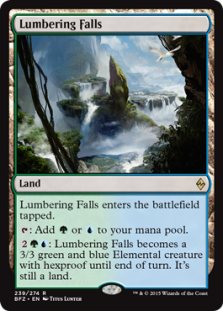 [/tippy] last week, and I wholeheartedly agree with his assessment on the Elemental-
[/tippy] last week, and I wholeheartedly agree with his assessment on the Elemental- in-disguise. Scapeshift and Temur Twin are going to love this new card and their metagame shares should benefit accordingly. In the early game, Falls gives extra mana-fixing to decks that lack manlands of their own. As a comparison, consider Jund and Abzan with Raging Ravine and Stirring Wildwood respectively. Even the underplayed Jeskai pairings get Celestial Colonnade! Once you hit the midgame, Falls really begins to shine. In many respects, you can think of it like a recurring Lightning Bolt when animated on an open board, which naturally plays well into strategies relying on Snapcaster Mage/Lightning Bolt for removal and reach. Falls is also strong in the Snapcaster mirror where incremental Tiago beats can quickly cost you the game both as an attacker and blocker.
in-disguise. Scapeshift and Temur Twin are going to love this new card and their metagame shares should benefit accordingly. In the early game, Falls gives extra mana-fixing to decks that lack manlands of their own. As a comparison, consider Jund and Abzan with Raging Ravine and Stirring Wildwood respectively. Even the underplayed Jeskai pairings get Celestial Colonnade! Once you hit the midgame, Falls really begins to shine. In many respects, you can think of it like a recurring Lightning Bolt when animated on an open board, which naturally plays well into strategies relying on Snapcaster Mage/Lightning Bolt for removal and reach. Falls is also strong in the Snapcaster mirror where incremental Tiago beats can quickly cost you the game both as an attacker and blocker.
 When evaluating a land like Falls, I look for both internal and contextual strengths. Falls definitely has the internal pieces (Hexproof is nuts in removal-clogged Modern games and three power is the perfect clock), but what about the metagame ones? Although Temur Twin remains a less-played Twin variant relative to its Grixis and UR competitors, Scapeshift enjoyed some high-profile success at the recent GP Oklahoma City. Matthew Dugan piloted the combo deck to an 8th place finish, and between his performance and the upcoming Falls release, I expect we'll see more Scapeshift to come. As an added bonus, Scapeshift follows a Lantern Control-style strategy of blanking removal by playing low-importance creatures. This fits nicely in recent metagame developments and is another reason I predict Falls slotting into these Temur combo/control lists.
When evaluating a land like Falls, I look for both internal and contextual strengths. Falls definitely has the internal pieces (Hexproof is nuts in removal-clogged Modern games and three power is the perfect clock), but what about the metagame ones? Although Temur Twin remains a less-played Twin variant relative to its Grixis and UR competitors, Scapeshift enjoyed some high-profile success at the recent GP Oklahoma City. Matthew Dugan piloted the combo deck to an 8th place finish, and between his performance and the upcoming Falls release, I expect we'll see more Scapeshift to come. As an added bonus, Scapeshift follows a Lantern Control-style strategy of blanking removal by playing low-importance creatures. This fits nicely in recent metagame developments and is another reason I predict Falls slotting into these Temur combo/control lists.
1. Lantern Scout
It's no secret that I love Allies in Modern and think they have a lot of unsung potential to make it big. Stephen Perigo thought so too, bringing his own take on Naya Allies to a Day 2 showing at GP Oklahoma City. Like many 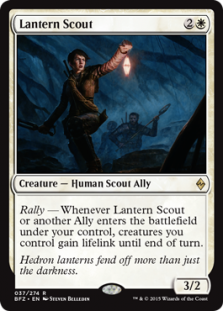 Allies players before him, Stephen relied on the mediocre Talus Paladin as a maindeck out against aggressive decks like Affinity and Burn. Ondu Cleric helped out of the sideboard, but the deck really needed an anti-aggro mechanism that synergized better with Aether Vial and, more importantly, Collected Company. Say hello to [tippy title="Lantern Scount" width="330" height="330"]
Allies players before him, Stephen relied on the mediocre Talus Paladin as a maindeck out against aggressive decks like Affinity and Burn. Ondu Cleric helped out of the sideboard, but the deck really needed an anti-aggro mechanism that synergized better with Aether Vial and, more importantly, Collected Company. Say hello to [tippy title="Lantern Scount" width="330" height="330"] [/tippy], a card I think will make the biggest overall impact on any single deck in Modern, although not necessarily on the format as a whole. Allies already had the trappings of a fringe tier 3 deck before Battle for Zendikar. Scout gives Allies the edge they need to make a solid push into tier 3 with some legitimate claim to tier 2 in the future. Allies already drew strength from a win-from-nowhere aggro gameplan with Akoum Battlesinger and Kabira Evangel. This bursty, linear, and decidedly proactive style gives it a slight edge over the more deliberate Merfolk approach (which, admittedly, isn't quite fair to the very one-hit-killer Master of Waves). Scout works so well in Allies because it converts your board presence advantages into life resources that Burn and Affinity can't overcome.
[/tippy], a card I think will make the biggest overall impact on any single deck in Modern, although not necessarily on the format as a whole. Allies already had the trappings of a fringe tier 3 deck before Battle for Zendikar. Scout gives Allies the edge they need to make a solid push into tier 3 with some legitimate claim to tier 2 in the future. Allies already drew strength from a win-from-nowhere aggro gameplan with Akoum Battlesinger and Kabira Evangel. This bursty, linear, and decidedly proactive style gives it a slight edge over the more deliberate Merfolk approach (which, admittedly, isn't quite fair to the very one-hit-killer Master of Waves). Scout works so well in Allies because it converts your board presence advantages into life resources that Burn and Affinity can't overcome.
If you're looking for Allies lists that leverage Lantern Scout and friends, check out Sky Mason's article from earlier this week. His new take on Naya Allies is sure to delight the tribal fan in everyone. As I talked about in my own article, I definitely think Collected Company is the way to go with Allies: explosive combat steps are what separates you from other aggro and Company decks like Naya, Slivers, etc. I think the jury is still out on Hardened Scales vs. Aether Vial, but that's a testing matter we'll undoubtedly resolve as more players bring Allies to the table. Expect to see this deck showing up more and more after BFZ makes its October debut.
Modern after BFZ
We shouldn't expect a lot of metagame shifts in the post-BFZ world. Only three of these five cards benefit upper-tier decks, with the other two still having a ways to go before they can reliably crack Day 2s and Top 8s across the Modern world. That said, some of these cards are likely only the beginning for their respective decks: Allies and Tron are sure to gain more as the set unfolds. As for Knight and Retreat, we'll have to wait and see how the brewers, tuners, and testers slap their Bant shells together: I'm optimistic that we'll see at least a few finishes with this deck on a big stage by the year's end.
What BFZ cards would make your Modern top five list? Any card evaluations you think I missed, or cards I gave too much/little credit? We have more Battle for Zendikar content coming throughout the week, so keep on reading as we figure out the best way to use our new set.






You don’t put Bring to Light in that top 5? I think it has potential….
I like Bring to Light, but don’t see it making big waves. You can use it with Scapeshift but the deck doesn’t really need 4 more Scapeshifts to be competitive. Ad Nauseam does want more of its namesake, but doesn’t want to play green and doesn’t always want it at sorcery speed. Living End is better in its existing shell, although Restore Balance is a bit more interesting (still worse than other decks). That leaves us with the less splashy utility functions for BtL, but I’m not convinced we want things like Goyf for five mana.
Care to change your views on BTL Scapeshift now that its pushed Scapeshift to T1?
Scapeshift isn’t tier 1 and the list that got T8 at Pittsburgh didn’t even run BtL. Although I still think BtL is decent, and I even bet on Scapeshift at Pittsburgh, it’s also clear that both the deck and the BtL version in particular have a long way to go in Modern.
Great article and insights Sheridan. Thanks for taking the time to write this up!
Of course! I’ll always try to do some kind of set review after a new release, although in weaker sets it might be more of a Top 5 than a Top 10 kind of piece.
What about Vampiric Rites? This card looks like a nice addition to the black modern pool. While I don’t think it should be in your top 5, I definitely see it as a playable. I also do not see it slotting into any top-tier decks. The card has potential with token generators and recursion creatures – it is like a pseudo evolutionary leap in black. It also gives black centric strategies a nice response to removal. What do you think about this card’s playability?
My biggest issue with Vampiric Rites is that it reminds me of both Barrage of Expendables (the bad Goblin Bombardment) and Molten Vortext (the worse Seismic Assault). Even Evolutionary Leap isn’t quite making it! None of these cards saw serious play or any play at all and Rites fits solidly in their category. It’s very rare for a card to slot into lower-tier decks and increase their playability without some very strong effect. Something like Lantern Scout can do it because it adds a crazy effect to an existing deck and the creature itself has few build-around requirements that Allies isn’t already fulfilling. Rites, however, seems just too niche and weak for Modern.
I agree with your comment there. This card is not a widespread playable, but it can provide value in a deck that fits its niche. Like perhaps a deck running Bitterblossom alongside Abyssal Persecutor and Bloodghast. Thanks for the response! Hope to read a ban list prediction soon
I’ve tried Vampiric Rites as a 2-of in my BW Soul Sisters/Humans deck. Briefly speaking, its the Soul Sisters + Ajani Pridemate, + Champion of the Parish as an alternate growing threat, with a black splash for Death Cultist + Bloodsoaked Champion, Phyrexian Arena and Dismember.
Because the deck cares about lifegain, I saw great opportunity in BFZ. Vampiric Rites when live is an absolute nightmare for opponents in the midgame – I chump block, sacrifice for lifegain, growing Pridemate and drawing a card. And heres where it gets sweeter – BfZ gave us a creature who cares about death – Zulaport Cutthroat.
Of course, using creatures as disposable assets is such a waste if you can’t bring them back – I also field Immortal Servitude. Bringing back Champions of the Parish, Soul Sisters, Bloodsoaked Champs and Death Cultists is terrific. Every time the opponent let me resolve that, the game was basically over.
I think the card Painful Truths has been hugely overlooked and is DEFINITELY playable. A 3 mana draw 3 currently doesn’t exist legally anywhere, and I think in the right shell it could be great as a 1/2 of.
On the one hand, Read the Bones is totally unplayable as a 3 mana draw 2 with selectivity. Sign in Blood is also unplayable as a 2 mana draw 2 with no selectivity. So i’m not sure where this leaves a 3 mana draw 3 with no selectivity, especially when it’s also sorcery speed. This seems like something you want to play later because getting this countered/Remanded early seems really bad, but I think there’s better things to do with your lategame mana. What shells do you see it fitting in?
I can potentially see it fitting into shells that desperately need better late game card draw or topdecks – Mardu shells come to mind because they can so completely run out of gas, and they can mitigate the lifeloss from lifelink effects. It’s a VERY hard card to evaluate because it doesn’t really exist in any context, but resolving a draw three when both players are hellbent basically reads : win the game.
I am excited about Knight+Corlhelm. Ive done some testing with proxies, and my guess is that Naya agro splash corlhelm (modled off of the stock Naya company agro list) is much stronger than Bant varients.
I am interested to see if CoCo even ends up in the stock lists, as a Dork + Retreat does a great impression of lotus cobra which could open many possibilities.
I’ve also seen the Domain Zoo or Blue Zoo take on the combo, and I see its merits over Bant. As an added bonus, Bant is basically nonexistent in Modern, whereas Naya is a much more established combination. This means you are working from a better initial shell than in the Bant builds. Can’t wait to see how these turn out!
Zulaport Cutthroat, while a little worse than Blood Artist, seems like it should have some number in the Abzan Rally deck that top 16’ed GPOKC. I seems like if that deck wants 5 sac outlets instead of 4 from a consistency standpoint it wants 5-6 Blood Artist effects. Maybe that leaves too few enablers, but we’ll see. If the deck has staying power then this card might end up in a “hindsight top 5”
Totally agree, and Blisterpod is a strictly better Thallid in that same list. If I had an honorable mention section, both cards would have made it. I actually discuss both of them in a recent Quiet Speculation article on Modern finance. You’ll need QS Insider but you can read it here:
https://www.quietspeculation.com/2015/09/insider-five-modern-pickups-after-battle-for-zendikar/
Another card to watch it’s Brutal Expulsion: it’s like 3 modes in 2. Protects from Abrupt Decay and Supreme Verdict, remands spells (without the cantrip part), damages planeswalkers, kills Etched Champions, Voices, Master of Waves, and Kitchen Finks.
Emeria Shepherd. You talked about UW, Emeria Shephers is very exiting or me as a UW player. 4 Sun Titan will turn into 3 Sun Titan, 1 Emeria Shepherd.
Oh no…you used “Tangoland”, isn’t there a better nickname for these lands? Personally, I like Slowlands, as coined by MTGGoldfish, but please not “Tangolands”.
“tangos” works fine, I expect this is the name that will stick.
I do not expect them to stick. Think about it, the phrase is “it takes two to tango” but there are three lands after it ETB.. That poor third leg would be left out. I saw someone on twitter say hedge lands because of the Hedge-mages from Eventide.
I tried it out at my LGS last week and hopefully it will stick! #hedgelands
I think ally encampment is probably going to be more important to allies than lantern scout – although both are the only slam dunks for the deck. Scout is an upgrade over cleric/mountain – encampment is an upgrade over basic plains… and being able to rebuy triggers has enormous potential, nevermind sacrificing a land to save your creature from a removal spell.
I can just imagine games where you rip a hada freeblade, and immediately use the encampment for a double set of triggers to win the game on the spot collected company style. And it’s got to be strong against wrath effects and mid-game spot removal. My only gripe on the card is that it swings the pendulum back towards aether vial – and I really like hardened scales ><
by mountain i mean paladin. derp.
I do not play allies but the other four picks look spot on. There might be another Eldrazi, such as Void Winower, or the Ally land that gets more play.
I would have put Tango-Lands at the number one spot. They help Emeria Control but I think most decks will want the enemy colour Tango’s if they get printed next time.
In addition to Lumbering Falls, I think Cinder Glade can benefit Scapeshift. Scapeshift is already loaded up on Mountain dual lands and having Cinder Glade to replace basic Mountains could make the mana base more consistent.
Newlamog will certainly be tried in Tron, though I’m not sure it’s a good match. Sundering Titan is very strong right now with Grixis and BGx in higher quantities. 2 Ugin seems to be the norm, though when 1 is played he’s usually accompanied by All is Dust.
Ulamog the Infinite Gyre (“Oldlamog”) is fantastic in grindy matchups, particularly those that play counterspells (read: Grixis). Destroying a permanent, eating a cryptic command, and reshuffling for the “do-over” two turns later is big game, especially since it’s harder to get up to 13/15 mana for the spaghetti monster to shut things down. The annihilate 4 trigger is extremely relevant: instead of a 2-3 turn clock where your opponent can play magic versus a 2-3 turn clock where your opponent loses all their lands and can’t play magic.
Newlamog exiling is relevant, but he isn’t resilient to countermagic, so I don’t think he’s flexible enough to make the final cut over the Infinite Gyre.
The case against lantern control is intriguing. Elsik stated that the Tron matchup can be sketchy, so the help MIGHT not be needed, though it’s unclear how many people will pick up the deck for competitive events. It’s certainly worth consideration if we wind up with lantern overlords.
Ultimately, I don’t think Tron wants Newlamog. I’ll be experimenting with it for sure, so we’ll see how things work out. I guess I won’t be surprised if it’s a slam dunk like Ugin. A lot of people were heavily against the planeswalking dragon because you can’t cast it T3, but then they tried it and found that exiling all their opponent’s colored permanents straight-up wins a lot of games, whether it is T4 or T10! My win percentage with a resolved Ugin is astoundingly high – the power of playing cards versus theorycrafting!